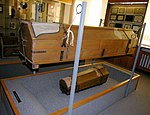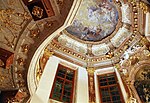Wien Quartier Belvedere railway station
Austrian Federal RailwaysRailway stations in Austria opened in 1962Railway stations in Austria opened in the 20th centuryRailway stations in Vienna

Wien Quartier Belvedere is a railway station in the fourth district of Vienna, served mainly by Vienna S-Bahn services. Opened in 1962 as the new underground S-Bahn platforms of the Südbahnhof main-line terminus, it was renamed to its present name when Südbahnhof was replaced by the new Hauptbahnhof station complex located further west.
Excerpt from the Wikipedia article Wien Quartier Belvedere railway station (License: CC BY-SA 3.0, Authors, Images).Wien Quartier Belvedere railway station
Wiedner Gürtel, Vienna Hungelbrunn (Wieden)
Geographical coordinates (GPS) Address Nearby Places Show on map
Geographical coordinates (GPS)
| Latitude | Longitude |
|---|---|
| N 48.187777777778 ° | E 16.38 ° |
Address
Quartier Belvedere
Wiedner Gürtel
1040 Vienna, Hungelbrunn (Wieden)
Austria
Open on Google Maps











